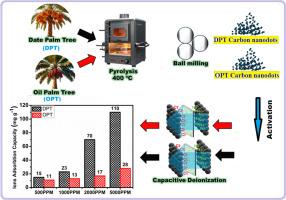从枣椰树和油棕树中提取的活性炭纳米点用于设计有效的电容去离子电极
IF 6.3
3区 工程技术
Q1 ENGINEERING, CHEMICAL
Journal of the Taiwan Institute of Chemical Engineers
Pub Date : 2025-08-26
DOI:10.1016/j.jtice.2025.106375
引用次数: 0
摘要
电容去离子(CDI)通过淡化微咸水,为缓解全球水资源短缺提供了一个有前途的解决方案。本研究考察了从枣椰树(DPT)和油棕树(OPT)中提取的活性炭纳米点(CNDs)在CDI电极设计中的效率。方法采用高能球磨法制备CNDs,经化学活化后获得高比表面积。其吸引人的特性主要是石墨含量、分层孔隙结构、高结晶性和高表面积(DPT和OPT的CNDs分别为945和750 m²/g)。此外,DPT的CNDs和OPT的CNDs的高比电容分别为291 F/g和175 F/g,这对CDI电极非常有用。结果表明,DPT的CNDs比OPT具有更好的CDI性能,在500 ~ 5000 ppm的不同NaCl浓度下,其盐吸附量为15 ~ 110 mg/g,化学稳定性更好。DPT的CNDs的平均盐吸附速率和电流效率也超过了OPT。这些发现强调了DPT活化CNDs作为高效和可持续的CDI电极用于咸淡水淡化的潜力。本文章由计算机程序翻译,如有差异,请以英文原文为准。

Activated carbon nanodots derived from date palm and oil palm trees for designing effective capacitive deionization electrodes
Background
Capacitive deionization (CDI) offers a promising solution for alleviating global water scarcity by desalinating brackish water. This study investigates the efficiency of activated carbon nanodots (CNDs) derived from date palm tree (DPT) and oil palm tree (OPT) biomass for designing CDI electrodes.
Methods
These CNDs were produced by the high energy ball milling technique and then chemically activated to achieve high surface area. Their attractive properties mainly their graphitic content, hierarchical pore structure, high crystalline nature and high surface area (945 and 750 m²/g for CNDs of DPT and OPT, respectively) are remarkable. Additionally, their high specific capacitances of 291 F/g for CNDs of DPT and 175 F/g for those of OPT are useful for CDI electrodes.
Significant Findings
The obtained results show that CNDs of DPT's have superior CDI performance than OPT, achieving salt adsorption capacities of 15–110 mg/g at various concentrations of NaCl within the range 500–5000 ppm with better chemical stability. The average salt adsorption rates and current efficiency of the CNDs of DPT also surpassed those of OPT. These findings underscore the potential of DPT activated CNDs as efficient and sustainable CDI electrodes for brackish water desalination.
求助全文
通过发布文献求助,成功后即可免费获取论文全文。
去求助
来源期刊
CiteScore
9.10
自引率
14.00%
发文量
362
审稿时长
35 days
期刊介绍:
Journal of the Taiwan Institute of Chemical Engineers (formerly known as Journal of the Chinese Institute of Chemical Engineers) publishes original works, from fundamental principles to practical applications, in the broad field of chemical engineering with special focus on three aspects: Chemical and Biomolecular Science and Technology, Energy and Environmental Science and Technology, and Materials Science and Technology. Authors should choose for their manuscript an appropriate aspect section and a few related classifications when submitting to the journal online.

 求助内容:
求助内容: 应助结果提醒方式:
应助结果提醒方式:


